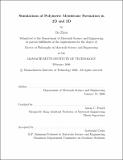Simulations of polymeric membrane formation in 2D and 3D
Author(s)
Zhou, Bo, Ph. D. Massachusetts Institute of Technology
DownloadFull printable version (4.976Mb)
Other Contributors
Massachusetts Institute of Technology. Dept. of Materials Science and Engineering.
Advisor
Adam C. Powell.
Terms of use
Metadata
Show full item recordAbstract
The immersion precipitation process makes most commercial polymeric membranes, which enjoy widespread use in water filtration and purification. In this work, a ternary Cahn-Hilliard formulation incorporating a Flory-Huggins homogeneous free energy function is used to model both initial diffusion and the liquid-liquid demixing stage of the immersion precipitation process, which determines much of the final morphology of membranes. Simulations start with a simple non-solvent/solvent/polymer ternary system with periodic boundary conditions and uniform initial conditions with small random fluctuations in 2D. Results in 2D demonstrate the effects of mobilities (Mij) and gradient penalty coefficients (Kij) on phase separation behavior. A two-layer polymer-solvent/non-solvent initial condition is then used to simulate actual membrane fabrication conditions. 2D simulation results demonstrate an asymmetric structure of membrane morphology, which strongly agrees with the experimental observation. A mass transfer boundary condition is developed to model the interaction between the polymer solution and the coagulation bath more efficiently. Simulation results show an asymmetric membrane with connected top layer. (cont.) Then a wide range of initial compositions are used in both the polymer solution and the coagulation bath, and the resulting morphology changes from isolated polymer droplets to bi-continuous pattern to continuous polymer with isolated pores. A nonuniform initial condition is proposed to model the evaporation of volatile solvent prior to immersion, which results in different time scale of the onset of spinodal decomposition and an asymmetric structure with different pore size in the membrane. Furthermore, a simple one-factor model is used to capture the concentration dependence of the polymer mobility in the low concentration range. Simulations with variable polymer mobility show faster coarsening kinetics. The membrane simulations are then extended to three dimensions. The 3D simulations show similar morphology as 2D results: an asymmetric structure with a dense layer on top of a porous bulk, but provide more information about the pore connectivity. The coarsening mechanism study confirmed the merge of the layers into the bulk membrane structure.. (cont.) Finally, ternary Cahn-Hilliard equations are coupled with the Navier-Stokes equations to include fluid flow driven by the interface curvature change during spinodal decomposition in two dimensions. Different formulation of the Navier-Stokes equation are evaluated for computational efficiency. 2D simulation results show that fluid flow destabilizes the top layer of membrane.
Description
Thesis (Ph. D.)--Massachusetts Institute of Technology, Dept. of Materials Science and Engineering, 2006. This electronic version was submitted by the student author. The certified thesis is available in the Institute Archives and Special Collections. Includes bibliographical references (p. 207-213).
Date issued
2006Department
Massachusetts Institute of Technology. Department of Materials Science and EngineeringPublisher
Massachusetts Institute of Technology
Keywords
Materials Science and Engineering.